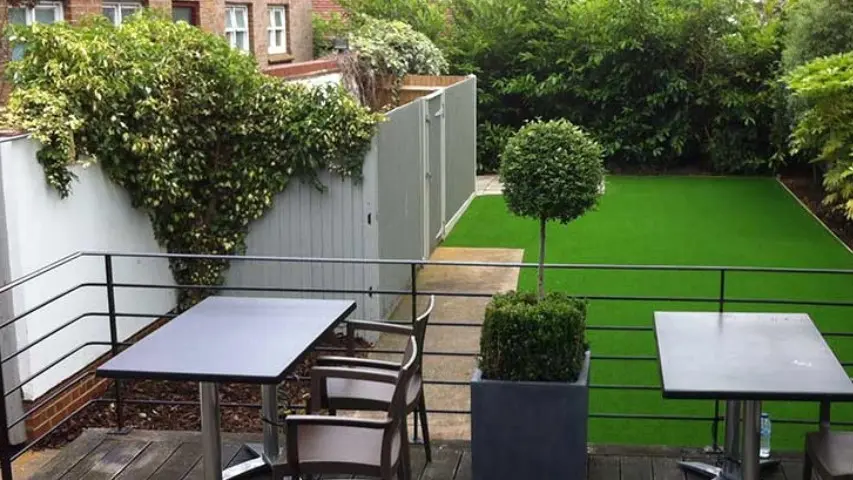What Is Artificial Turf?
Synthetic turf is an artificial surface of fibers designed to resemble natural grass. Its low maintenance and resilience make it popular for sports venues, play areas, and home yards. In contrast to natural grass, synthetic turf requires no watering, mowing, or fertilization, making it an environmentally friendly choice for regions experiencing water scarcity or homeowners looking to reduce lawn maintenance responsibilities. It is available in various pile heights, colors, and textures to suit different environments and needs.
When considering artificial turf for residential or commercial spaces, selecting a high-quality product that mimics the look and feel of natural grass is essential. Miller Sports Construction offers guidance on evaluating installation quality, drainage, and longevity. A well-installed artificial turf system can provide a safe, attractive, and functional space that requires minimal upkeep.
Key Benefits of Artificial Turf
The decision to install artificial turf is driven by numerous factors, with environmental and economic advantages taking the front stage. One of the paramount benefits is water conservation, a critical concern in the face of increasing global water scarcity. Homeowners choosing artificial turf may conserve as much as 55 gallons of water for each square foot yearly since there’s no need for irrigation. Beyond water savings, artificial turf offers remarkable durability, often exceeding 15 years of life with proper maintenance, providing a steadfast and vibrant appearance. Unlike natural grass, synthetic turf eliminates the necessity for mowing, fertilizing, and re-seeding, leading to considerable savings in time and effort.
Another significant advantage is the versatility that artificial turf offers. It provides a neat and uniform appearance regardless of foot traffic or weather conditions. It holds well in arid and humid climates, expanding its usability across diverse locales. Reducing lawn-related allergies and pest avoidance adds to its benefits, allowing families and pets to engage with their outdoor spaces more freely and comfortably.
Choosing the Right Artificial Turf
Selecting the right artificial turf involves carefully considering several elements, including pile height, density, color, and intended use. These features are crucial as they impact the turf’s visual appeal and functional value. For instance, higher pile heights lend a more luxurious and lush appearance, making them ideal for front yards and scenic installations. In contrast, denser turf types are suited for areas with high foot traffic, such as playgrounds or athletic fields, due to their hard-wearing nature. Product certifications play a vital role, guaranteeing the turf meets essential safety and quality standards. Consulting product certification resources provides an extra layer of assurance, guiding your choice to the safest, most enduring turf available.
Installation Tips for Artificial Turf
Installing artificial turf is a pivotal factor influencing its performance and longevity. Initial groundwork involves preparing the base by excavating and leveling the target area to achieve a smooth, stable foundation. This stage is critical as it establishes the groundwork for optimal turf performance. Ensuring an efficient drainage system is another crucial consideration, as it prevents water accumulation, thereby mitigating potential damage over time. Expert installations often incorporate a perforated drainage layer, facilitating adequate water flow and avoiding pooling issues. By adhering to these installation guidelines and learning from professionals’ experiences, you can achieve a seamless and resilient artificial turf setup.
Maintenance Best Practices
While artificial turf is known for its minimal upkeep demands, consistent maintenance is vital to fortify its lifespan and visual appeal. Routine care primarily involves removing debris, brushing fibers to remain upright, and occasionally washing with water to cleanse the surface. Seasonal adjustments to maintenance practices are essential for optimizing drainage systems and adapting to changing environmental conditions. Utilizing industry resources ensures that your artificial turf consistently excels aesthetically and functionally.
Residential Applications of Artificial Turf
The versatility of artificial turf in residential environments is extensively appreciated for its effortless beauty and functionality, maintaining a vibrant appearance all year round. For homes in water-scarce areas, synthetic turf is a highly effective alternative, substantially reducing water consumption and maintenance expenses. Its utility extends beyond lawns, finding applications in rooftop gardens, patios, and indoor play areas, providing flexible solutions for enhancing any living space. Parents appreciate the clean, resilient, and safe surface artificial turf offers, presenting a perfect playground for children while contributing to their property’s overall value and aesthetic appeal.
Commercial Uses of Artificial Turf
Commercial entities have increasingly gravitated towards artificial turf, recognizing its functional benefits and aesthetic merits. Its inherent low-maintenance nature makes artificial turf an appealing choice for sports fields, office landscapes, and commercial properties, where it maintains a polished appearance with minimal effort. Businesses can realize significant long-term savings by eliminating lawn maintenance and irrigation expenses. Moreover, artificial turf provides a consistent surface quality, elevating its usability and enhancing the visual allure of commercial venues, contributing positively to brand image and customer experience.
Common Misconceptions About Artificial Turf
Despite its proven advantages, artificial turf is often surrounded by misconceptions concerning its environmental impact and safety. Modern technological advancements have mitigated many of these concerns, with new infill technologies addressing issues such as heat retention. Additionally, contemporary turf products are designed to be recyclable, aligning with sustainable environmental practices. By dispelling common myths, individuals are better positioned to make informed choices, embracing artificial turf as a sustainable, practical, and stylish solution for enhancing their outdoor spaces.
Also Read- The Art of Edgebanding: Exploring Innovative Solutions



